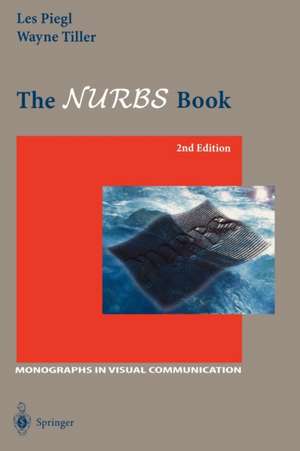The NURBS Book: Monographs in Visual Communication
Autor Les Piegl, Wayne Tilleren Limba Engleză Paperback – 14 noi 1996
Preț: 508.08 lei
Preț vechi: 635.10 lei
-20% Nou
Puncte Express: 762
Preț estimativ în valută:
97.23€ • 101.14$ • 80.27£
97.23€ • 101.14$ • 80.27£
Carte disponibilă
Livrare economică 24 martie-07 aprilie
Livrare express 08-14 martie pentru 49.78 lei
Preluare comenzi: 021 569.72.76
Specificații
ISBN-13: 9783540615453
ISBN-10: 3540615458
Pagini: 664
Ilustrații: XIV, 646 p.
Dimensiuni: 155 x 235 x 40 mm
Greutate: 0.95 kg
Ediția:2nd ed. 1997
Editura: Springer Berlin, Heidelberg
Colecția Springer
Seria Monographs in Visual Communication
Locul publicării:Berlin, Heidelberg, Germany
ISBN-10: 3540615458
Pagini: 664
Ilustrații: XIV, 646 p.
Dimensiuni: 155 x 235 x 40 mm
Greutate: 0.95 kg
Ediția:2nd ed. 1997
Editura: Springer Berlin, Heidelberg
Colecția Springer
Seria Monographs in Visual Communication
Locul publicării:Berlin, Heidelberg, Germany
Public țintă
ResearchCuprins
One Curve and Surface Basics.- 1.1 Implicit and Parametric Forms.- 1.2 Power Basis Form of a Curve.- 1.3 Bézier Curves.- 1.4 Rational Bézier Curves.- 1.5 Tensor Product Surfaces.- Exercises.- Two B-Spline Basis Functions.- 2.1 Introduction.- 2.2 Definition and Properties of B-spline Basis Functions.- 2.3 Derivatives of B-spline Basis Functions.- 2.4 Further Properties of the Basis Functions.- 2.5 Computational Algorithms.- Exercises.- Three B-spline Curves and Surfaces.- 3.1 Introduction.- 3.2 The Definition and Properties of B-spline Curves.- 3.3 The Derivatives of a B-spline Curve.- 3.4 Definition and Properties of B-spline Surfaces.- 3.5 Derivatives of a B-spline Surface.- Exercises.- Four Rational B-spline Curves and Surfaces.- 4.1 Introduction.- 4.2 Definition and Properties of NURBS Curves.- 4.3 Derivatives of a NURBS Curve.- 4.4 Definition and Properties of NURBS Surfaces.- 4.5 Derivatives of a NURBS Surface.- Exercises.- Five Fundamental Geometric Algorithms.- 5.1 Introduction.- 5.2 Knot Insertion.- 5.3 Knot Refinement.- 5.4 Knot Removal.- 5.5 Degree Elevation.- 5.6 Degree Reduction.- Exercises.- Six Advanced Geometric Algorithms.- 6.1 Point Inversion and Projection for Curves and Surfaces.- 6.2 Surface Tangent Vector Inversion.- 6.3 Transformations and Projections of Curves and Surfaces.- 6.4 Reparameterization of NURBS Curves and Surfaces.- 6.5 Curve and Surface Reversal.- 6.6 Conversion Between B-spline and Piecewise Power Basis Forms.- Exercises.- Seven Conics and Circles.- 7.1 Introduction.- 7.2 Various Forms for Representing Conics.- 7.3 The Quadratic Rational Bézier Arc.- 7.4 Infinite Control Points.- 7.5 Construction of Circles.- 7.6 Construction of Conies.- 7.7 Conic Type Classification and Form Conversion.- 7.8 Higher Order Circles.- Exercises.-Eight Construction of Common Surfaces.- 8.1 Introduction.- 8.2 Bilinear Surfaces.- 8.3 The General Cylinder.- 8.4 The Ruled Surface.- 8.5 The Surface of Revolution.- 8.6 Nonuniform Scaling of Surfaces.- 8.7 A Three-sided Spherical Surface.- Nine Curve and Surface Fitting.- 9.1 Introduction.- 9.2 Global Interpolation.- 9.3 Local Interpolation.- 9.4 Global Approximation.- 9.5 Local Approximation.- Exercises.- Ten Advanced Surface Construction Techniques.- 10.1 Introduction.- 10.2 Swung Surfaces.- 10.3 Skinned Surfaces.- 10.4 Swept Surfaces.- 10.5 Interpolation of a Bidirectional Curve Network.- 10.6 Coons Surfaces.- Eleven Shape Modification Tools.- 11.1 Introduction.- 11.2 Control Point Repositioning.- 11.3 Weight Modification.- 11.4 Shape Operators.- 11.5 Constraint-based Curve and Surface Shaping.- Twelve Standards and Data Exchange.- 12.1 Introduction.- 12.2 Knot Vectors.- 12.3 Nurbs Within the Standards.- 12.4 Data Exchange to and from a NURBS System.- Thirteen B-spline Programming Concepts.- 13.1 Introduction.- 13.2 Data Types and Portability.- 13.3 Data Structures.- 13.4 Memory Allocation.- 13.5 Error Control.- 13.6 Utility Routines.- 13.7 Arithmetic Routines.- 13.8 Example Programs.- 13.9 Additional Structures.- 13.10 System Structure.- References.
Textul de pe ultima copertă
The NURBS book covers all aspects of non-uniform rational B-splines necessary to design geometry in a computer aided environment. Basic B-spline features, curve and surface algorithms, and state-of-the-art geometry tools are all discussed. Detailed code for design algorithms and computational tricks are covered too, in a lucid, easy-to-understand style, with a minimum of mathematics and using numerous worked examples. The book is a must for students, researchers, and implementors whose work involves the use of splines.
"Some years ago a few researchers joked about NURBS, saying that the acronym really stands for Nobody Understands Rational B-Splines write the authors in their foreword; they formulate the aim of changing NURBS to EURBS, that is, Everybody ... . There is no doubt that they have achieved this goal. ...
... I highly recommend the book to anyone who is interested in a detailed description of NURBS. It is extremely helpful for students, teachers and designers of geometric modelling systems. ..."
- H. Pottmann, Computer Aided Design, 1996
"Some years ago a few researchers joked about NURBS, saying that the acronym really stands for Nobody Understands Rational B-Splines write the authors in their foreword; they formulate the aim of changing NURBS to EURBS, that is, Everybody ... . There is no doubt that they have achieved this goal. ...
... I highly recommend the book to anyone who is interested in a detailed description of NURBS. It is extremely helpful for students, teachers and designers of geometric modelling systems. ..."
- H. Pottmann, Computer Aided Design, 1996


















